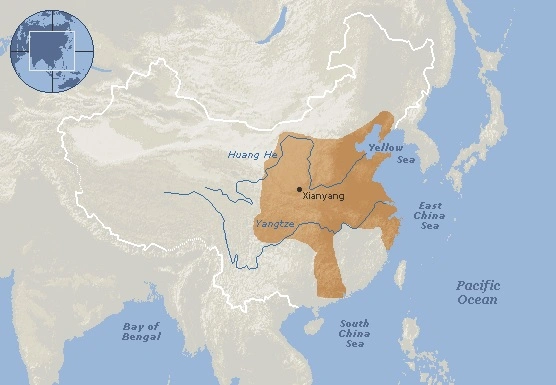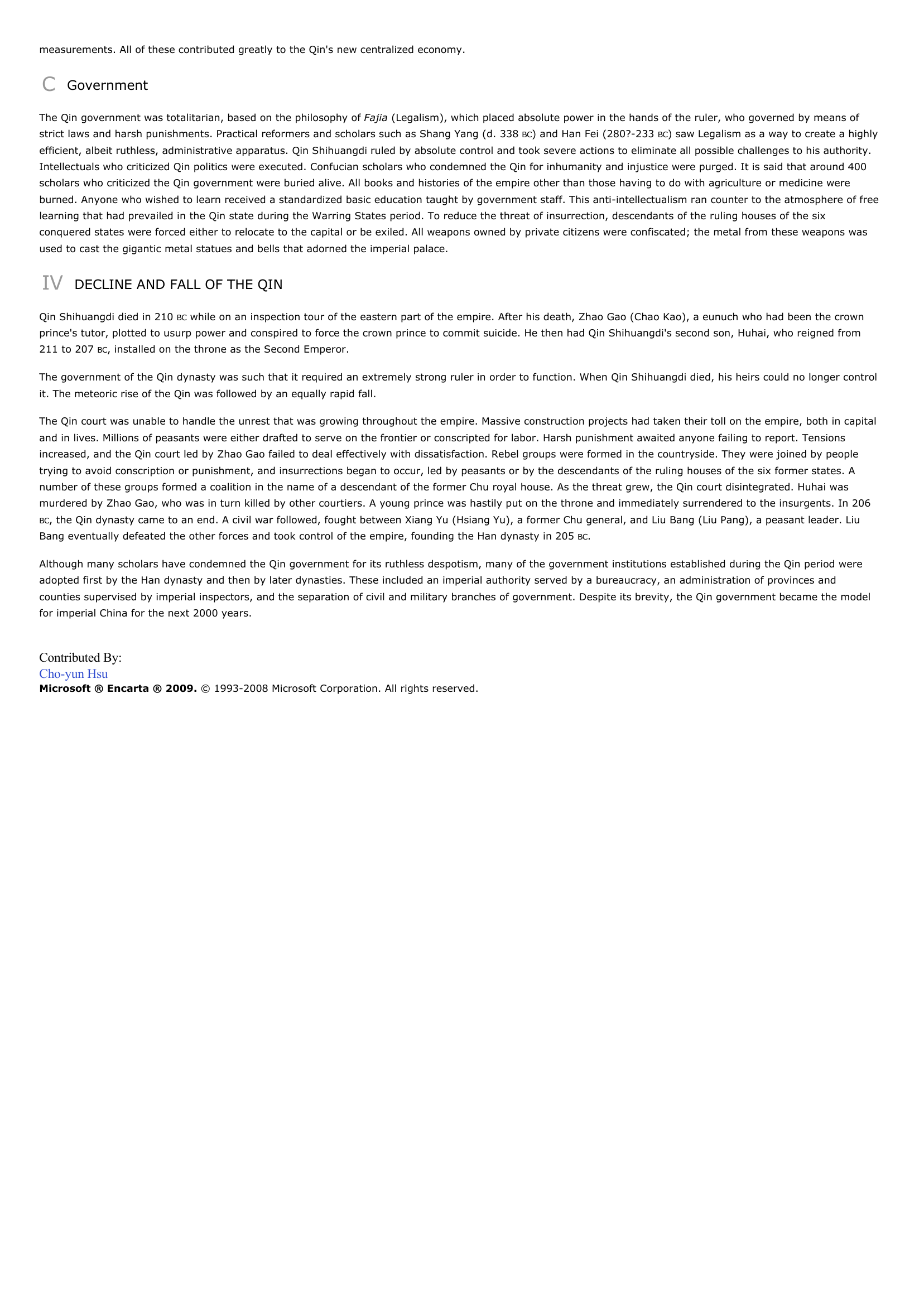Qin Dynasty - History.
Publié le 02/05/2013

Extrait du document


«
measurements.
All of these contributed greatly to the Qin's new centralized economy.
C Government
The Qin government was totalitarian, based on the philosophy of Fajia (Legalism), which placed absolute power in the hands of the ruler, who governed by means of strict laws and harsh punishments.
Practical reformers and scholars such as Shang Yang (d.
338 BC) and Han Fei (280?-233 BC) saw Legalism as a way to create a highly efficient, albeit ruthless, administrative apparatus.
Qin Shihuangdi ruled by absolute control and took severe actions to eliminate all possible challenges to his authority.Intellectuals who criticized Qin politics were executed.
Confucian scholars who condemned the Qin for inhumanity and injustice were purged.
It is said that around 400scholars who criticized the Qin government were buried alive.
All books and histories of the empire other than those having to do with agriculture or medicine wereburned.
Anyone who wished to learn received a standardized basic education taught by government staff.
This anti-intellectualism ran counter to the atmosphere of freelearning that had prevailed in the Qin state during the Warring States period.
To reduce the threat of insurrection, descendants of the ruling houses of the sixconquered states were forced either to relocate to the capital or be exiled.
All weapons owned by private citizens were confiscated; the metal from these weapons wasused to cast the gigantic metal statues and bells that adorned the imperial palace.
IV DECLINE AND FALL OF THE QIN
Qin Shihuangdi died in 210 BC while on an inspection tour of the eastern part of the empire.
After his death, Zhao Gao (Chao Kao), a eunuch who had been the crown prince's tutor, plotted to usurp power and conspired to force the crown prince to commit suicide.
He then had Qin Shihuangdi's second son, Huhai, who reigned from211 to 207 BC, installed on the throne as the Second Emperor.
The government of the Qin dynasty was such that it required an extremely strong ruler in order to function.
When Qin Shihuangdi died, his heirs could no longer controlit.
The meteoric rise of the Qin was followed by an equally rapid fall.
The Qin court was unable to handle the unrest that was growing throughout the empire.
Massive construction projects had taken their toll on the empire, both in capitaland in lives.
Millions of peasants were either drafted to serve on the frontier or conscripted for labor.
Harsh punishment awaited anyone failing to report.
Tensionsincreased, and the Qin court led by Zhao Gao failed to deal effectively with dissatisfaction.
Rebel groups were formed in the countryside.
They were joined by peopletrying to avoid conscription or punishment, and insurrections began to occur, led by peasants or by the descendants of the ruling houses of the six former states.
Anumber of these groups formed a coalition in the name of a descendant of the former Chu royal house.
As the threat grew, the Qin court disintegrated.
Huhai wasmurdered by Zhao Gao, who was in turn killed by other courtiers.
A young prince was hastily put on the throne and immediately surrendered to the insurgents.
In 206BC, the Qin dynasty came to an end.
A civil war followed, fought between Xiang Yu (Hsiang Yu), a former Chu general, and Liu Bang (Liu Pang), a peasant leader.
LiuBang eventually defeated the other forces and took control of the empire, founding the Han dynasty in 205 BC.
Although many scholars have condemned the Qin government for its ruthless despotism, many of the government institutions established during the Qin period wereadopted first by the Han dynasty and then by later dynasties.
These included an imperial authority served by a bureaucracy, an administration of provinces andcounties supervised by imperial inspectors, and the separation of civil and military branches of government.
Despite its brevity, the Qin government became the modelfor imperial China for the next 2000 years.
Contributed By:Cho-yun HsuMicrosoft ® Encarta ® 2009. © 1993-2008 Microsoft Corporation.
All rights reserved..
»
↓↓↓ APERÇU DU DOCUMENT ↓↓↓
Liens utiles
- Qin Dynasty - history.
- Qing Dynasty - history.
- Han Dynasty - history.
- Shang Dynasty - history.
- Han Dynasty - history.
















